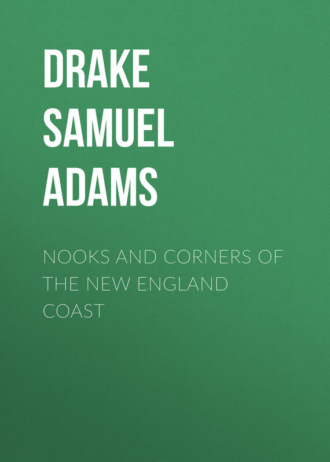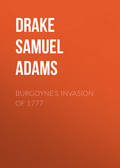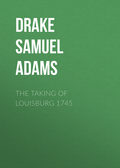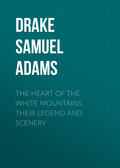
Drake Samuel Adams
Nooks and Corners of the New England Coast
The reader knows the pretty story, so gracefully told by Mr. Longfellow, of Martha Hilton, who became the second wife of Governor Benning,129 and thus Lady Wentworth of the Hall.
We can see her as she goes along the street, swinging the pail, a trifle heavy for her, and splashing with the water her naked feet. We hear her ringing laughter, and the saucy answer to Mistress Stavers in her furbelows, as that buxom landlady flings at her, in passing, the sharp reproof:
"O Martha Hilton! Fie! how dare you go
About the town half-dressed and looking so?"
The poet's tale is at once a history and a picture, full of pretty conceits and picturesque situations. Fancy the battered effigy of the Earl of Halifax on the innkeeper's sign falling at the feet of Mrs. Stavers to declare his passion.
But Benning Wentworth, governor though he was, was none too good for Martha Hilton.130 It was the pride of the Hiltons made her say, "I yet shall ride in my own chariot." The widowed governor was gouty, passionate, and had imbibed with his long residence in Spain the hauteur of the Spaniard. He left office in 1766 in disgrace.
The last of the colonial Wentworths was Sir John, in whose favor his uncle had been allowed to screen himself by a resignation. There are some odd coincidences in the family records of both uncle and nephew. The former's widow made a second marriage to a Wentworth; the latter married his widowed cousin, Frances Wentworth.131
The mansion of Sir John may be seen in Pleasant Street, Portsmouth. He was the last royal governor of New Hampshire. John Adams mentions that as he was leaving his box at the theatre one night in Paris, a gentleman seized him by the hand: "'Governor Wentworth, sir,' said the gentleman. At first I was embarrassed, and knew not how to behave toward him. As my classmate and friend at college, and ever since, I could have pressed him to my bosom with most cordial affection. But we now belonged to two different nations, at war with each other, and consequently were enemies."
The king afterward gave Sir John the government of Nova Scotia. The poet Moore mentions the baronet's kind treatment of him in 1805, during his American tour. He is said to have kept sixteen horses in his stable at Portsmouth, and to have been a free-liver. A man of unquestioned ability to govern, who went down under the great revolutionary wave of 1775, but rose again to the surface and struck boldly out.
There is now in the possession of James Lenox, of New York, a portrait of the baronet's wife, by Copley, painted in his best manner. The lady was a celebrated beauty. The face has caught an expression, indescribably arch, as if its owner repressed an invincible desire to torment the artist. In it are set a pair of eyes, black and dangerous, with high-arched brows, a tempting yet mocking mouth, and nose a little retroussé. Her natural hair is decorated with pearls; a string of them encircles her throat. The corsage is very low, displaying a pair of white shoulders such as the poet imagined:
"She has a bosom as white as snow,
Take care!
She knows how much it is best to show,
Beware! beware!"
In 1777 Baron Steuben arrived in Portsmouth, in the Flamand. Franklin had snubbed him, St. Germain urged him, but Beaumarchais offered him a thousand louis-d'or.132 On the day the baron joined the army at Valley Forge his name was the watchword in all the camps.
CHAPTER XIV.
SALEM VILLAGE, AND '92
Banquo. "Were such things here as we do speak about?
Or have we eaten of the insane root,
That takes the reason prisoner?" —Macbeth.
Salem Village has a sorrowful celebrity. It would seem as if an adverse spell still hung over it, for in the changes brought by time to its neighbors it has no part, remaining, as it is likely to remain, Salem Village – that is to say, distinctively antiquated, sombre, and lifeless.
A collection of houses scattered along the old high-road from Salem to Andover, decent-looking, brown-roofed, though humble dwellings, a somewhat pretending village church, and pleasant, home-like, parsonage; old trees, partly verdant, partly withered, stretching naked boughs above the gables of houses even older than themselves, embody something of the impressions of oft-repeated walks in what is known as the "Witch Neighborhood."
The village contains one central point of paramount interest. It is an inclosed space of grass ground, a short distance from the principal and only street, reached by a well-trodden by-path. Within this now naked field once stood a house, with a garden and orchard surrounding. Of the house nothing remains except a slight depression in the soil; of the orchard and garden there is no trace; yet hard by I chanced on a bank of aromatic thyme once held of singular potency in witchcraft – as in the "Faerie Queen," the tree laments to the knight:
"I chanced to see her in her proper hue,
Bathing herself in origan and thyme."
In this quiet, out-of-the-way little nook, Salem witchcraft had its beginning. The sunken cavity is what remains of the Ministry House, so called, pulled down in 1785 (not a day too soon); the den of error in which the plague-spot first appeared. No one would have thought, standing here, that he surveyed the focus of malevolence so deadly as the wretched delirium of '92.
The well-informed reader is everywhere familiar with the origin and development of Salem witchcraft.133 It has employed the best pens as it has puzzled the best brains among us; until to-day the whole affair remains enveloped in a mystery which the theories of nearly two hundred years have failed wholly to penetrate.
The writer has had frequent occasion to know how wide-spread is the belief that witchcraft began in New England, and particularly in Salem. This is to be classed among popular errors upon which repeated denials have little effect. Nevertheless, witchcraft did not originate in New England; no, nor in old England either, for that matter. The belief in it was earlier than the Mayflower, older than the Norman Conquest, and antedated the Roman Empire. The first written account of it is contained in Scripture.134
Saul incurred the anger of God by consulting the Witch of Endor. Joan of Arc was burned as a witch in 1431. About fifty years later the Church of Rome fulminated a bull against witchcraft. The number of suspected persons already burned at the stake or subjected to the most cruel torments is estimated at many thousands.
In taking leave of the Dark Ages we do not take our leave of witchcraft. More than a hundred thousand victims had perished in Germany and France alone before the Mayflower sailed from Delft. The Pilgrims, I engage, believed in it to a man.
Old England! Why, the statute against witchcraft was not repealed until 1736, in the second George's time, though it had lain dormant some years. The last recorded execution in the British Islands occurred in Scotland, as late as 1722. The sixth chapter of Lord Coke's "Third Institutes" is devoted to a panegyric on the statutes for punishing "conjuration, sorcery, witchcraft, or enchantment." The laws of England were the fundamental law of New England; witchcraft was in the list of recognized crimes throughout Christendom.
France, under Louis le Grand, whose style history will change, notwithstanding his famous "L'etat c'est moi," to Louis the Little, was immeshed in the net of superstition. The highest personages of the court resorted to the astrologers for horoscopes, charms, or philters. We might see later the magic and sorcery of the sixteenth century and of the seventeenth transformed into studies in chemistry under the Regency, and become experiments in magnetism in the eighteenth century.
The settlers in New England, who brought all their Old-World superstitions with them, were not surprised to find the Indians fully impregnated with a belief in magic equal to their own. The wonderful cures of the Indian magicians or medicine-men were thoroughly believed in, and are vouched for by white evidence. One of their favorite methods of revenging private injury was by enchanting a hair, which entered the bodies of their enemies and killed them while sleeping. It is noted that Tituba, an Indian, had much to do with the outbreak in Salem village.
Sir William Phips, an illiterate but not incapable man, had been appointed Governor of Massachusetts Bay, under the new charter of William and Mary. The charter conferred the power of civil government, and separated the legislative from the judicial authority. Sir William constituted a commission of seven to try the witchcraft cases at Salem. As he had no power to create such a court under the charter, one of the saddest reflections that arise from these bloody proceedings is that twenty persons suffered death for an imaginary crime, inflicted by an illegal tribunal. The province law of 1692 decreed death for "enchantment, sorcery, charm, or conjuration, or invocation, or to feed any wicked spirit."
The first authenticated case of witchcraft in New England, and also the first execution, took place at Boston, as early as 1648. The culprit, Margaret Jones, of Charlestown, was suspected of having and using the "malignant touch." She professed some knowledge of medicine, and probably availed herself of the awe in which she was held by the superstitious to ply her trade. Many other cases are mentioned in the other colonies, Connecticut bearing her full share, before the climax of 1692 is reached. Then, as afterward, the accusations fell chiefly upon women; the old, friendless, or half-witted bearing the burden of every accident in their neighborhood.
An English writer gravely says in 1690: "Several old women suspected for witches in and about Lancashire have been often noted to have beards of considerable growth, tho' that's no general rule, some of the reverend and virtuous being often liable to the same." Everywhere witchcraft was received as a stubborn fact. The criminal codes of nearly if not quite all the colonies recognized it. In Pennsylvania, if tradition may be believed, the fact was met by no less stubborn common sense. It is said, when Philadelphia was three years old, a woman was brought before Governor Penn, charged with witchcraft and riding through the air on a broomstick. Although the woman confessed her guilt, she was dismissed by the Quaker magistrate with the assurance that, as there was no law against it, she might ride a broomstick as often as she pleased.
Could a full and candid confession be obtained of the present generation there would appear more superstition than we wot of, such as would show us legitimate descendants of credulous colonists. It is not long since a staid old town in Massachusetts was in consternation at the report of a ghost in a school-room. Signs and portents have been handed down and are religiously believed in by other than the ignorant and credulous, as has been already stated in a former chapter. A very small proportion of the skeptical could be induced to enter a church-yard at night. There is some subtle principle of our nature that gives ready adhesion to the mystical or the marvelous; and it is believed they were not differently constituted in 1692.
Leaving the Witch Ground, the visitor, in retracing his steps, will pass near the old Nurse House, a memorial of one of the most damning of the innocent sacrifices to superstition. It is not easy to sit down and write of it with the indifference of the professional historian.
Rebecca Nurse, aged and infirm, universally beloved by her neighbors, was accused. The jury, moved by her innocence, having brought in a verdict of "not guilty," the court sent them out again with instructions to find her guilty. She was executed. The tradition is that her sons disinterred her body by stealth from the foot of the gallows, where it had been thrown, and brought it to the old homestead, laying it reverently and with many tears in the little burying-ground which the family always kept, and which is still seen near by.
But briefly to our history. We there discover that twenty persons lost their lives through the denunciation of eight simple country girls, the youngest being eleven, and the oldest not more than twenty years of age.135 These maidens met at the house of Samuel Parris, the then minister of the village, and on the spot where the earth is now trying to heal the scar left by the old cellar. They formed what was then and is still known as a "circle" in New England, devoted in these more modern days to clothing the heathen and bewitching the youth who enter their influence.
The most plausible, and therefore the commonly received opinion is, that these girls, having at first practiced some of the well-known methods of performing magic, were led into a series of false accusations which, from being conceived in a spirit of mischief, grew into crimes of the first magnitude as they found themselves carried away by a frenzy they had not moral courage to stay. Another presumption supposes the girls believers in their own powers. This view is sustained by the universal belief in witchcraft, the ready adhesion given to their charges, the support they received from the judges, and the terrible power with which they found themselves possessed. Another solution is found in the occult influences of second-sight so widely credited in Scotland in years by-gone, the psychology and clairvoyance of the present day. Dr. Samuel Johnson said he would rather believe in second-sight than in the poetry of Ossian. If the soundest thinkers of the nineteenth century are staggered to account for the phenomena of spirit-rappings, it is wise to defer a hasty condemnation of the "possessed damosels" of Salem village.
Instead of plying its needles, the circle was engaged in attempts to discover the future. Rev. John Hale, in his "Modest Inquiry into the Nature of Witchcraft," has this to say:
"I fear some young persons, through a vain curiosity to know their future condition, have tampered with devil's tools, so far that thereby one door was opened to Satan to play those pranks —Anno 1692. I knew one of the Afflicted persons, who (as I was credibly informed), did try with an egg and a glass to find her future husband's calling; till there came up a coffin, that is, a spectre in likeness of a coffin. And she was afterward followed with diabolical molestation to her death; and so dyed a single person. A just warning to others, to take heed of handling the devil's weapons lest they get a wound thereby." This John Hale, teacher of the people, was at first a zealous believer. Perhaps the denunciation of his own wife had something to do with his backsliding into common sense.
The accusing girls were believed infallible witch-finders. Their services were consequently in demand as their fame spread abroad. Some of them were taken to Andover, leaving distrust, dismay, and death in the quiet old West Parish. "In a short time," says the annalist, "it was commonly reported forty men of Andover could raise the devil as well as any astrologer."
A "Boston Man" having taken his sick child to Salem in order to consult the afflicted ones, obtained the names of two of his own towns-people as the authors of its distemper; but the Boston justices refused warrants to apprehend them, and Increase Mather asked the father if there was not a God in Boston that he must go to the devil in Salem. These two persons are said to have been Mrs. Thatcher, mother-in-law of Curwin, one of the judges,136 and the wife of Sir William Phips.
As soon as the prosecutions stopped, it was remarked that the apparitions ceased. Once or twice the accuser recoiled before a sharp and swift reproof, as at Lieutenant Ingersoll's, when one of them cried out, "There's Goody Procter!" Raymond and Goody Ingersoll told her flatly she lied; there was nothing. The girl was cowed, and "said she did it for sport."
Even the witchcraft horrors have a humorous side – grimly humorous, it is true, like the jokes cracked in a dissecting-room. The thought of pots and kettles jumping on the crane, of anchors leaping overboard of themselves, and of hay-cocks found hanging to trees is rather mirth-provoking. Mirrors were daily consulted by maids and widows looking for a husband. A matter of life and death could not prevent George Jacobs, the old grandfather, from laughing heartily at the spasmodic antics of Abigail Williams.
It seems a pity that New England in her greatest need should have found no champion, like St. Dunstan, to argue with and finally compel the devil to own himself confuted, as, according to vulgar belief, he did, by taking the fiend by the nose with a pair of red-hot tongs; or as Ignatius Loyola, who, when disturbed at his devotions by the devil, seized his cudgel and drubbed him away.137 Montmorency, a peer and marshal of France, son of the famous Bouteville, whom Richelieu had caused to be decapitated for fighting a duel at midday in the Place Royal, was weak enough to visit La Voisin, the renowned conjuror and fabricator of poisons in the reign of Louis XIV. La Voisin had promised to show him the devil, and the duke was curious. When the maréchal whipped out his rapier and thrust vigorously at the spectre, it fell on its knees, and begged its life. The devil proved to be a confederate of La Voisin. Archibald, duke of Argyle, was haunted by blue phantoms – the origin of our epithet for melancholy, "blue devils."
In the village tavern there was a battle with spectres that Abigail Williams and Mary Walcut declared were present. Benjamin Hutchinson and Eleazer Williams pulled out their swords and cut and stabbed the air until, as the two girls averred, the floor was deep in ghostly blood!
A ride through the woods then was little coveted by the stoutest hearts. A spark of fear is soon blown into uncontrollable panic. Bushes grew spectres and trees outstretched goblin arms. Elizabeth Hubbard was riding home from meeting on the crupper, behind old Clement Coldum. The rustling leaves were witches' whisperings, the white birches seemed ghosts in their winding-sheets. The woman, faint-hearted and overmastered by a nameless dread, cried out to the goodman to ride for life – the woods were full of devils. Though he could see none, the valiant rider spurred his horse like mad, and rode as Tam O'Shanter rode his fearful race when pursued by the witches of Kirk Alloway.
The trysting-place of the witches was in Parris's pasture. It was here Abigail Hobbs, who had sold herself to the "Old Boy," attending, saw the sacrament of the "red bread and the red wine" administered to the devil's elect. Poor George Burroughs, whom we met for a moment in our walk through Wells, was denounced for summoning with a trumpet the attending witches. Obedient to the sound, from far and near, the withered beldams, toothless hags in short petticoats, white linen hoods, and conical high crowned hats, come flocking on flying broomsticks. Satan is there in person, not playing the bagpipe, as in Tam O'Shanter's fearful conclave, but with the conventional book written in letters of blood.
Certes, these were but rude ghosts. Nowadays the devil is raised as easily, but conducts himself with greater propriety, as becomes the devil of the nineteenth century. The damp grass of the church-yard and the witches' den are bugbears no longer. We sit in a comfortable apartment around a mahogany table. Our ghost no more appears in mouldy shroud, but, like a well-bred spectre, knocks for admittance. Soon his card will be handed in on a salver, and we may perhaps in time expect daily weather reports from the nether world.
Before leaving the village, I turned into one of those old abandoned roads in which I like so well to walk. Left on one side by a shorter cut, saving some rods to this hurrying age, the deserted by-way conducts you into solitudes proper for communion with the past. Grass has sprung up so thickly as almost to conceal traces of the once well-worn ruts, now only two indistinct lines of lighter green. Young pines, a foot high, are rooted in the cart-way; stone walls, moss-grown and tumbling down. Here and there are the ghastly remains of some old orchard, the ground strewed with withered branches. A half-obliterated cellar denotes a former habitation; even the land betrays evidences of having been turned by the plows of two centuries ago. Who have passed this way? Perhaps the laying-out of this very road begot disputes transmitted from father to son.
A mile beyond the Witch Neighborhood the Andover road crosses the Newburyport turnpike. At the junction of the two roads stands the old farm-house in which Israel Putnam, the "Old Put" of the Revolutionary army, was born.
The house, or rather houses, for two structures compose it, is still occupied by Putnams. The newer building, already old by comparison with some of its neighbors, was built in 1744; the original in 1650, or thereabouts, according to family tradition. One object, to which the attention of every visitor is directed, is the old pollard of enormous girth standing near the house. House and tree seem types of the sturdy, indomitable old man, who at nearly three-score was full of the rage of battle.
By the courtesy of the family, ever ready to indulge a proper curiosity, I looked over the old house from garret to cellar. The little room in which the general was born remains just as when its rough-hewn posts and thick beams were revealed to his astonished gaze. There are few relics of the general remaining.
While in the Wadsworth Museum at Hartford, I lately saw the damaged sign displayed by Putnam when he kept an inn at Brooklyn, Connecticut, about 1768. Another famous soldier, Murat, was the son of an aubergiste, and Napoleon was not too willing on this account to give him the hand of his sister.
The Putnams settled early in Salem. John, the first emigrant, came from Buckinghamshire, in 1634, with three sons, Thomas, Nathaniel, and John. Some of the name exercised a fatal influence during the reign of witchcraft. Israel was already an old man when he left his plow in the furrow to gallop to Cambridge, having been born in 1718. At twenty-one he removed to Pomfret, Connecticut. Putnam was prompt, resolute, and incapable of fear – full of fight, and always ready. Washington, who did not judge badly, thought him the only fit man to make an assault on Boston. Though uneducated, Putnam wrote pithily, as to Governor Tryon:
"Sir, – Nathan Palmer, a lieutenant in your king's service, was taken in my camp as a spy; he was condemned as a spy; and he shall be hanged as a spy.
"P.S. —Afternoon. He is hanged."
Danvers, in whose territory we have been rambling, is an aggregate of several widely scattered villages taken from Salem in the last century. Some of its villages have grown into good-sized, prosperous towns, and one has taken the name of her eminent banker-philanthropist, George Peabody. When at Salem, the visitor may easily reach Peabody, Danvers, and the Witch Neighborhood by rail, having in the latter instance a walk of a mile before him on leaving the little station near the Putnam House. In a circuit of several miles, embracing what is to be seen of interest on this side, it is, perhaps, better to leave Salem by the old Boston road and return to it by the Andover highway. Following this route, we successively pass by Governor Endicott's farm, on which is still seen the aged pear-tree, sole relic of the ancient orchard,138 the house which became the head-quarters in 1774 of General Gage, and the Witch Neighborhood. But before hurrying away from Peabody, it will be well to read the inscription on the monument which one sees in the main street,139 examine the memorials of royal munificence in the library of the Institute,140 and, if the stranger be of my mind, to halt for a moment before the humble dwelling in which Bowditch was born. As there is no place in New England which so highly prizes its antique memorials and traditions as Salem, the first person you meet will be able to direct you to the one or relate to you the other.







